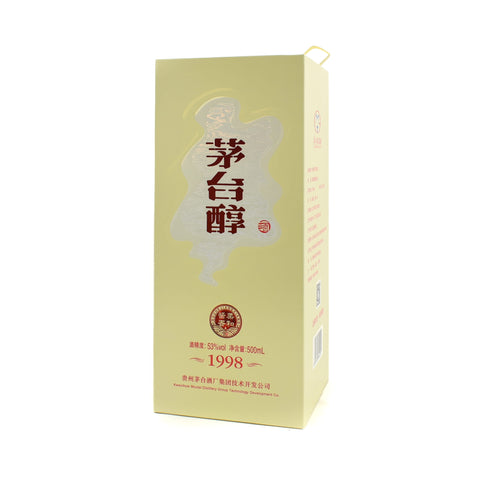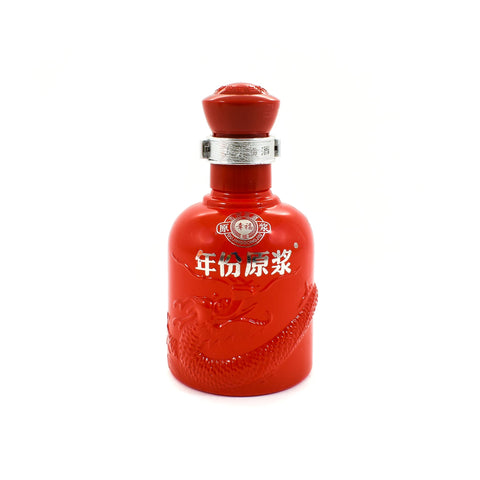A Guide To Baijiu - The World’s Most Popular Spirit
by Nicola Lando

Chinese baijiu is an alcoholic spirit that is so frequently drunk in China, it outsells all other spirits sold across the world… and yet it’s likely you’ve never heard of it.
Bastien Ciocca - owner of the first ever Baijiu-dedicated cocktail bar in Guangzhou - describes the drink as, ‘a rich category of spirits as diverse as whisky or wine‘, and yet until more recently, its unique complexity of varieties and aromas have been unknown and underappreciated outside China.
What is Baijiu?
Baijiu is a crystal-clear alcoholic spirit that is typically distilled from a base of water, sorghum (a flowering plant) and grains such as wheat or barley, rice, glutinous rice, wheat, or other grains, making it one of the most unique liquors in the world. Its history as a cultural and culinary pillar in China is long and deep-rooted, dating back thousands of years to when alcohol was consumed not only for pleasure, but for medicinal or religious purposes.
Baijiu is very strong - typically 40 - 60% alcohol - and yet it offers a complexity of fruit, citrus, floral and umami flavours.
How is Baijiu made?
‘All Baijius have three very distinct things in common‘ says Derek Sandhaus, founder of Ming River Baijiu and author of ‘Baijiu: The Essential Guide to Chinese Spirits’ and ’Drunk in China: Baijiu and the World’s Oldest Drinking Culture’, ‘grain is the only ingredient in the mashbill (the building block of fermentation) - they are fermented and distilled in a solid form using a grain-based culture called Qu (pronounced chew), and aged in natural surfaces, which traditionally means terracotta jars‘.
Baijiu Bottles
The unique brewing techniques and cultural significance of baijiu are often reflected in the design, color and quality of baijiu bottles, which are highly valued in Chinese society.
Aside from these common factors, every Baijiu is unique to its distillery and it is the combination different types of grains and the Qu that define its aroma and flavour, along with the type and length of fermentation.
What does Baijiu taste like?
While the central component of Baijiu’s flavour can be described as ‘savoury’, there is a vast range of complex differences in the flavour profiles of regional varieties. In addition to traditional varieties, you can also find baijiu infused with various flavors, offering a unique twist on the classic spirit. According to Chockie Tom, Baijiu rep and expert, these range from ‘salty, earthy, soy-sauce-like umami notes all the way to rice, funky, overripe tropical fruit‘.
Main Types of Baijiu
There are 5 dominant sub-categories of style of baijiu, making it one of the most diverse beverages in the world: Strong, Sauce, Light, Rice, and Mixed Aromas.
Strong Aroma
Strong Aroma is the most widely available and popular subcategory of Baijiu. It is the type most commonly consumed by those who drinks baijiu in China. It typically offers fruity and floral layers of flavours, particularly herbal and citrus notes. It is the largest sub-category and accounts for almost two thirds of Baijiu production.
Notes include: apple, pepper, pineapple, aniseed.
Strong Aroma with notes of soy sauce, sweet fruits and floral scents
A traditional strong baijiu with a signature fiery punch and fragrant delicate finish.
Sauce Aroma
Sauce aroma varieties of Baijiu are commonly noted for their rich, umami, soy sauce notes, which offer a more traditionally earthy fermented flavour. Moutai is one of the most prestigious producers of Baijiu, and it is often said that drinking enough Maotai can solve any diplomatic challenge, highlighting its cultural significance.
Notes include: soy, mushroom, caramel.
Moutai is one of the most prestigious producers of Baijiu, as well as the world’s most valuable spirit brand.
A central soy sauce aroma with very subtle fruity notes of melon, apricot and green apple.
Light Aroma
Light aroma varieties offer a typically softer, less pungent flavour, and are a perfect gentle introduction to the spirit.
Notes include: apricot, pear, pine wood.
Light notes of green apple and a hint of Matcha.
It's bitterness is offset by a subtle sweetness from the addition of corn sugar.
Rice Aroma
Rice aroma varieties are among the more unique of the Baijiu sub-categories as they are distilled from purely rice or glutinous rice. Rice Aroma baijiu is often compared to vodka due to its clear appearance and smooth taste, but it offers a more complex flavor profile than whiskey. However, some experts feel that this quality means they do not qualify as Baijiu.
Notes include: rice, floral, soft lemon.
Mixed Aroma
Mixed aroma Baijiu varieties are often a combination of Baijiu from the other 4 categories, with the most frequent being the Strong and Sauce varieties.
Notes include: a mixture of any of the other categories but predominantly Strong and Sauce Aromas.
- A classic mixed Baijiu of lower percentage so ideal for those looking to try the spirit for the first time.
- One of the stronger of the traditional Gujinggong baijius and leaves a lingering peppery note.
How does Baijiu vary by region?
Much like wine, the production process for baijiu is regionally unique, making it one of the most diverse beverages in China, using local grains and varying fermentation techniques. Strong Aroma Baijius are the pride of the southwestern Sichuan province, whereas Light Aromas are much more common in the North.
Kweichow Moutai is one of the most prestigious producers of Baijiu, renowned for their Sauce Aroma Baijiu, which is solely produced in the town of Moutai in the Guizhou province. The grains used and production process are unique to the town and hence only Baijius made here can be categorised as a Moutai Baijiu product, much like the Appellation d’Origine Contrôlée system that applies to French wine production. Moutai Baijiu has been produced in the small town for over 200 years.
How is Baijiu drunk?
Baijiu is traditionally drunk neat at room temperature and in the form of small shots. It is consumed in toasts alongside meals - often to excess! - leading to its reputation as a ‘social lubricant‘ among drinkers, says Derek Sandhaus. It is also regularly consumed during business meetings, at celebrations and other social gatherings. In China, it is considered impolite to drink Baijiu alone, and hence baijiu bottles are often saved for special occasions.
Drinking is a social activity in China and Baijiu etiquette is a practice often adhered to.
One must always drink a full shot, but only when a toast is made. A toast must also always be reciprocated, but note that you must never toast before the host.
In more recent years, Baijiu has become popular as an ingredient in cocktails, due to its intensity of flavour. In Opium in London, Baijiu is mixed with with Jamaican Rum and jasmine to make a tropical, sweet and floral Clarified Shanghai Punch. Due to its complexity and variation of flavour, Baijiu is not simply interchangeable ingredients in cocktails or with other flavours, so experimenting with the aromas is an art.
Why have I never heard of Baijiu?
Baijiu has been slow to increase in popularity around the world, and this could be due to a number of factors. Lack of understanding of the spirit could be one reason, says Derek Sandhaus, ‘Baijiu is a very complex and complicated spirits category, and it takes time and dedication to appreciate its nuances‘. However, Bastien Ciocca puts it down to simple supply and demand: ‘the consumption is so great within China that we thought there was not a strong need to expand overseas’.
More recently Baijiu has started to gain the international respect, understanding and appreciation that it deserves. More recently, baijiu infused with various flavors has started to gain popularity, offering a unique twist on the traditional spirit. Drinks experts love it for its complexity of flavour, rich heritage and versatility. It now features on the cocktail menus of some of London’s top destinations, in bars such as China Tang in The Dorchester Hotel and Gong Shangri-La at the Shard.
Baijiu is the drink your spirit cabinet is missing and what better time to add a bottle to your collection than another Chinese cultural landmark in Lunar New Year. Browse our full collection of bottles of Baijius to experience this unique and special drink for yourself.
For those who prefer a more personalised experience, consider experimenting with Baijiu at home. Start by selecting a Baijiu variety that suits your taste—whether it’s the strong aroma with its intense flavours, or the light aroma for a gentler introduction. Once you’ve chosen your Baijiu, prepare a simple cocktail by mixing it with familiar ingredients like ginger or lemon juice. You could also add a splash of boiling water to release the aromas further. Store your Baijiu in an airtight container to maintain its freshness and prevent any flavours from fading. Whether you’re sharing a drink with friends or exploring Baijiu’s complexities on your own, this versatile spirit is sure to become a favourite addition to your collection.

About the author
Nicola is co-founder and CEO at Sous Chef. She has worked in food for over ten years.
Nicola first explored cooking as a career when training at Leiths, before spending the next decade in Finance. However... after a stage as a chef at a London Michelin-starred restaurant, Nicola saw the incredible ingredients available only to chefs. And wanted access to them herself. So Sous Chef was born.
Today, Nicola is ingredients buyer and a recipe writer at Sous Chef. She frequently travels internationally to food fairs, and to meet producers. Her cookbook library is vast, and her knowledge of the storecupboard is unrivalled. She tastes thousands of ingredients every year, to select only the best to stock at Sous Chef.
Nicola shares her knowledge of ingredients and writes recipes to showcase those products. Learning from Sous Chef's suppliers and her travels, Nicola writes many of the recipes on the Sous Chef website. Nicola's recipes are big on flavour, where the ingredients truly shine (although that's from someone who cooks for hours each day - so they're rarely tray-bakes!).





